Category: NMEA 2000, 0183 & Signal K
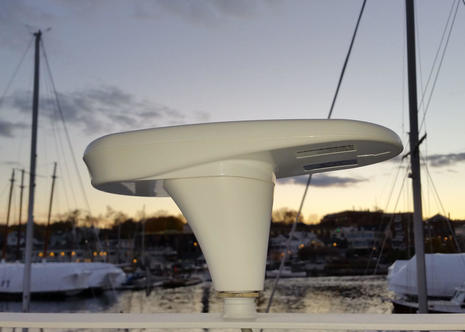 There’s lot to report from the Fort Lauderdale Show, but the calendar dictates that I first write about this Seapilot satellite compass. That’s because a startling 50% show discount is still available this week, so you can buy the Vector Compact-N NMEA 2000 model seen above for $500 simply by applying the code “FLIBS2015” in the shopping cart. The Compact seemed like a relatively good value at twice the price when I first discussed its features last November, and since then I’ve seen it perform pretty well on Gizmo…
There’s lot to report from the Fort Lauderdale Show, but the calendar dictates that I first write about this Seapilot satellite compass. That’s because a startling 50% show discount is still available this week, so you can buy the Vector Compact-N NMEA 2000 model seen above for $500 simply by applying the code “FLIBS2015” in the shopping cart. The Compact seemed like a relatively good value at twice the price when I first discussed its features last November, and since then I’ve seen it perform pretty well on Gizmo…
 Sorry for the fuzzy photo, but it makes sense as the iKommunicate Signal K Gateway isn’t a real product yet, and the real product may look quite different from the “Proof of Concept” prototype above if it actually materializes early next year. Why so vague? What’s happening here is a techy chicken and egg thing. Digital Yacht was understandably hesitant about developing a gateway for Signal K apps and services that hardly exist yet, but the Signal K universal boat data concept — open source, entirely free, and created by unfunded volunteers — needs a commercial level NMEA gateway so that third party developers can easily show us what the potential apps and services can do. That’s my understanding of why DY launched the iKommunicate Kickstarter campaign and also why I’m hoping that fellow boat geeks and related companies will join me in backing the project and thus helping Signal K become real…
Sorry for the fuzzy photo, but it makes sense as the iKommunicate Signal K Gateway isn’t a real product yet, and the real product may look quite different from the “Proof of Concept” prototype above if it actually materializes early next year. Why so vague? What’s happening here is a techy chicken and egg thing. Digital Yacht was understandably hesitant about developing a gateway for Signal K apps and services that hardly exist yet, but the Signal K universal boat data concept — open source, entirely free, and created by unfunded volunteers — needs a commercial level NMEA gateway so that third party developers can easily show us what the potential apps and services can do. That’s my understanding of why DY launched the iKommunicate Kickstarter campaign and also why I’m hoping that fellow boat geeks and related companies will join me in backing the project and thus helping Signal K become real…
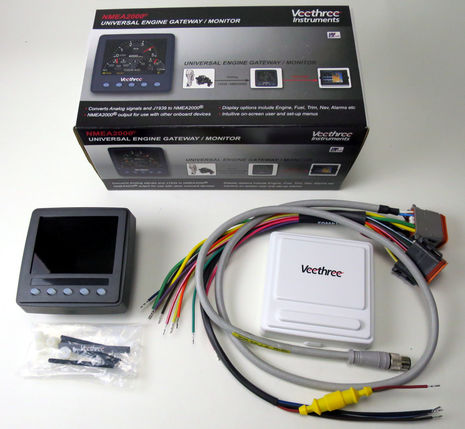 Veethree is a serious instrumentation company with significant engineering and manufacturing facilities in Florida and India (impressive corporate video here). The vast majority of their business is OEM, so while the ruggedly-built Engine Gateway Monitor (EGM) above is packaged as a retail product, you’re not apt to see one at a marine store and it’s even hard to find at Veethree (go to the bottom of this marine page). But my testing suggests that it could be useful on many boats, especially with a few of the firmware features coming to its big brother, the 800 EGM…
Veethree is a serious instrumentation company with significant engineering and manufacturing facilities in Florida and India (impressive corporate video here). The vast majority of their business is OEM, so while the ruggedly-built Engine Gateway Monitor (EGM) above is packaged as a retail product, you’re not apt to see one at a marine store and it’s even hard to find at Veethree (go to the bottom of this marine page). But my testing suggests that it could be useful on many boats, especially with a few of the firmware features coming to its big brother, the 800 EGM…
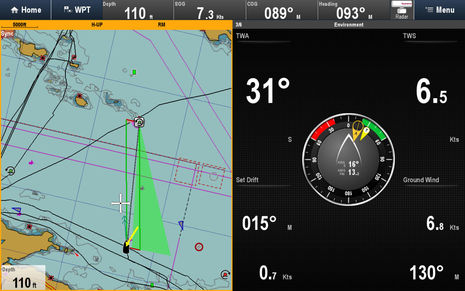 When pretending to sail, I go for high performance. That’s why the screen above seems to show Gizmo exceeding true wind speed while extremely close hauled. But pretending is also why I can’t truly review the new sailing features that came to all current Raymarine multifunction displays last May, thanks to a free LightHouse 14 operating system update. Additionally, most of the features described in the press release are about racing, which I did little of even when I was sailing a lot. But let’s walk through the new Raymarine MFD capabilities anyway, and hopefully we’ll hear from sailors who’ve actually used these tools or the similar ones offered by B&G and Garmin…
When pretending to sail, I go for high performance. That’s why the screen above seems to show Gizmo exceeding true wind speed while extremely close hauled. But pretending is also why I can’t truly review the new sailing features that came to all current Raymarine multifunction displays last May, thanks to a free LightHouse 14 operating system update. Additionally, most of the features described in the press release are about racing, which I did little of even when I was sailing a lot. But let’s walk through the new Raymarine MFD capabilities anyway, and hopefully we’ll hear from sailors who’ve actually used these tools or the similar ones offered by B&G and Garmin…
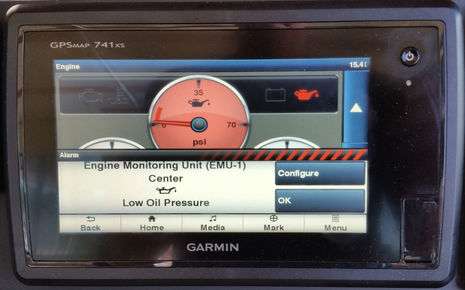 On Oct. 4th I’ll present a seminar titled “Electronic Engine Monitoring Comes of Age” at TrawlerFest Bay Bridge in Stevensville, Maryland. This Garmin 741 photo will be useful as it shows three new and different ways Gizmo’s old diesel engine can now indicate a low oil pressure problem. Thanks to the Actisense EMU-1 I installed in 2013, the simple low pressure alarm switch on the Volvo Penta can trigger an informative pop-up (and audio alarm) on all the networked Garmin screens regardless of what function(s) they’re showing. And if the engine gauge page is up, the familiar low oil pressure icon lights up and, better yet, the customizable digital psi dial can go red based not on the alarm switch, but rather on a minimum pressure I’ve set. That’s all good, but modern marine electronics can do even better…
On Oct. 4th I’ll present a seminar titled “Electronic Engine Monitoring Comes of Age” at TrawlerFest Bay Bridge in Stevensville, Maryland. This Garmin 741 photo will be useful as it shows three new and different ways Gizmo’s old diesel engine can now indicate a low oil pressure problem. Thanks to the Actisense EMU-1 I installed in 2013, the simple low pressure alarm switch on the Volvo Penta can trigger an informative pop-up (and audio alarm) on all the networked Garmin screens regardless of what function(s) they’re showing. And if the engine gauge page is up, the familiar low oil pressure icon lights up and, better yet, the customizable digital psi dial can go red based not on the alarm switch, but rather on a minimum pressure I’ve set. That’s all good, but modern marine electronics can do even better…
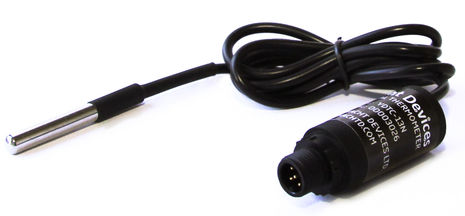 One of the most valuable improvements I’ve made on Gizmo is a Maretron TMP100 able to put six different temperature sensors on the boat’s NMEA 2000 network, particularly the one I’ve set to alarm me if the engine block gets even slightly hotter than normal. I wrote about the plan in 2013 and will detail how well it worked out soon. Closely monitoring certain temperatures can save a lot of hassle and money though one impediment is the need for either a Maretron DSM display or a USB Gateway to configure the setup. It’s intriguing then to learn of Yacht Devices’ $99 N2K temp sensor with its clever cost-free configuration. But there are some potential issues…
One of the most valuable improvements I’ve made on Gizmo is a Maretron TMP100 able to put six different temperature sensors on the boat’s NMEA 2000 network, particularly the one I’ve set to alarm me if the engine block gets even slightly hotter than normal. I wrote about the plan in 2013 and will detail how well it worked out soon. Closely monitoring certain temperatures can save a lot of hassle and money though one impediment is the need for either a Maretron DSM display or a USB Gateway to configure the setup. It’s intriguing then to learn of Yacht Devices’ $99 N2K temp sensor with its clever cost-free configuration. But there are some potential issues…
 Wow! Today the National Marine Electronics Association — also known as NMEA, or IMEA for its International reincarnation — announced recognition of the Signal K open source marine data project. It’s clearly not an endorsement, but it does provide clear methods to gateway NMEA 2000 boat data to the Internet-friendly universal marine data model that the Signal K is about. And that’s plenty good enough, I think. In fact, as the title above wonders, this may turn out to be a very big deal. I also think it marks a nice evolution for NMEA. Though criticism of this trade and standards organization from outside the small world of hardcore marine electronics has largely been unfair, NMEA could do better fitting into the much bigger and faster-moving data/app universe, and now they’re trying harder…
Wow! Today the National Marine Electronics Association — also known as NMEA, or IMEA for its International reincarnation — announced recognition of the Signal K open source marine data project. It’s clearly not an endorsement, but it does provide clear methods to gateway NMEA 2000 boat data to the Internet-friendly universal marine data model that the Signal K is about. And that’s plenty good enough, I think. In fact, as the title above wonders, this may turn out to be a very big deal. I also think it marks a nice evolution for NMEA. Though criticism of this trade and standards organization from outside the small world of hardcore marine electronics has largely been unfair, NMEA could do better fitting into the much bigger and faster-moving data/app universe, and now they’re trying harder…
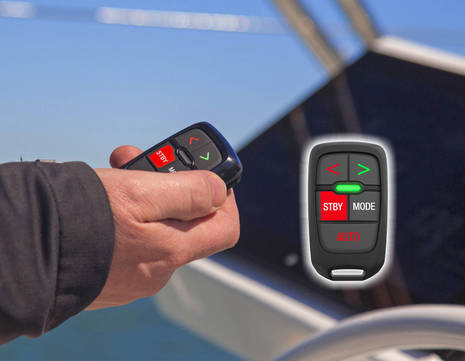
Last week Navico introduced a Wireless Pilot Controller that can be added to B&G, Simrad, and Lowrance autopilots that connect to their control heads (and/or MFD controls) via NMEA 2000. It can do more than the keys indicate — like tack a sailboat that’s being steered in wind mode — and it will retail at $349 with a BT-1 Bluetooth Base Station. The WR10 remote will also be available by itself for $150 as four can work with one BT-1 at once, and eventually the remote may be able to work directly with the Bluetooth built into displays like the recently introduced Lowrance HDS Gen3 or the new Simrad Go7 / B&G Vulcan V7 twins…
The brand new Simrad Go7 looks like an all-glass version of the Simrad NSS7 evo2 Combo, but its design may actually define an interesting new “standalone” glass bridge MFD style that trades some of...
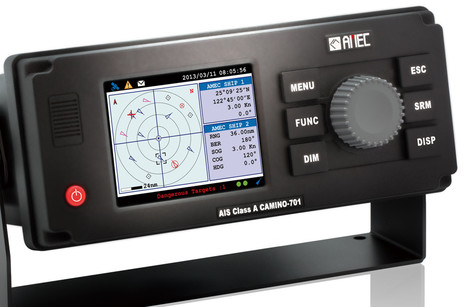 There are several reasons that a yacht or workboat might want to use an AIS Class A transceiver instead of Class B, even if they’re not required to. With Class A you’ll be seen by other boats from a greater distance because you’ll be transmitting at 12W instead of 2, and you’ll be tracked much more smoothly — particularly if you’re going fast and/or manuevering — because the Class A update rate for dynamic data like position, speed, and heading is much more frequent than Class B. The problem is that the total install cost of Class A can be quite high and especially annoying on a modern boat with a NMEA 2000 network — despite what you may have read on Panbo! — because no Class A truly supported N2K until the AMEC Camino 701 came along (and it’s not perfect yet)…
There are several reasons that a yacht or workboat might want to use an AIS Class A transceiver instead of Class B, even if they’re not required to. With Class A you’ll be seen by other boats from a greater distance because you’ll be transmitting at 12W instead of 2, and you’ll be tracked much more smoothly — particularly if you’re going fast and/or manuevering — because the Class A update rate for dynamic data like position, speed, and heading is much more frequent than Class B. The problem is that the total install cost of Class A can be quite high and especially annoying on a modern boat with a NMEA 2000 network — despite what you may have read on Panbo! — because no Class A truly supported N2K until the AMEC Camino 701 came along (and it’s not perfect yet)…
 There’s lot to report from the Fort Lauderdale Show, but the calendar dictates that I first write about this Seapilot satellite compass. That’s because a startling 50% show discount is still available this week, so you can buy the Vector Compact-N NMEA 2000 model seen above for $500 simply by applying the code “FLIBS2015” in the shopping cart. The Compact seemed like a relatively good value at twice the price when I first discussed its features last November, and since then I’ve seen it perform pretty well on Gizmo…
There’s lot to report from the Fort Lauderdale Show, but the calendar dictates that I first write about this Seapilot satellite compass. That’s because a startling 50% show discount is still available this week, so you can buy the Vector Compact-N NMEA 2000 model seen above for $500 simply by applying the code “FLIBS2015” in the shopping cart. The Compact seemed like a relatively good value at twice the price when I first discussed its features last November, and since then I’ve seen it perform pretty well on Gizmo…
















